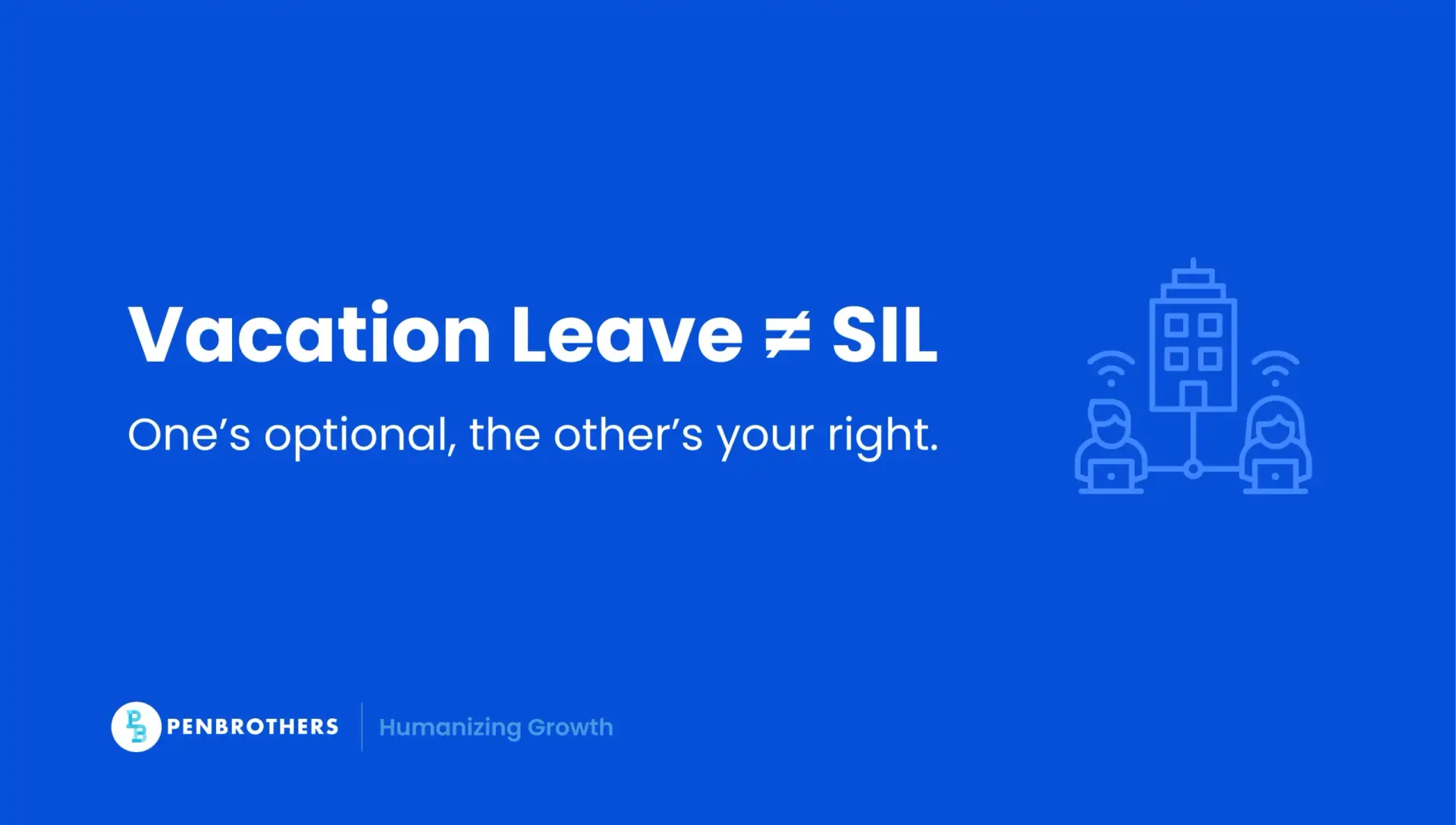What's Inside?
Service Incentive Leave: A Complete 2025 Guide for Remote & Hybrid Employees

Key Takeaways
1. SIL is a compliance shield. Clear SIL documentation protects employers from DOLE disputes and costly back pay.
2. Remote workers still qualify. If paid via a PH entity or EOR, remote employees are entitled to SIL. No exceptions.
3. Misclassification risks are costly. Wrongly labeling staff as “field personnel” or “contractors” to avoid SIL invites labor claims.
Introduction
Remote work changed where we clock in, but it didn’t erase the benefits guaranteed under Philippine labor law. One of the most misunderstood among these is Service Incentive Leave (SIL). This is a statutory five-day paid leave that applies even to remote and hybrid employees.
The challenge? Many employers confuse SIL with vacation leave or sick leave, and some remote workers don’t even realize they’re entitled to it. Worse, misclassifying employees as freelancers has left many without benefits they’re legally owed.
This guide clears the fog. You’ll find eligibility rules, gray-area clarifications, cash conversion computations, and remote-specific applications, explained from a compliance perspective but written to be practical for employees and employers alike. By the end, you’ll know exactly how SIL works, how much you can claim, and what to watch out for in both contracts and payroll.
What Is Service Incentive Leave (SIL)?
At its simplest, SIL is a mandatory benefit under the Philippine Labor Code. It grants five days of paid leave per year to qualified employees, regardless of whether they use it for rest, vacation, or illness.
But SIL isn’t just a “time-off perk.” From a compliance lens, it serves three purposes:
- Legal safeguard: Protects employees’ right to paid rest and ensures due process during audits or disputes.
- Retention tool: Employees who see benefits enforced fairly are more likely to stay.
- Alignment mechanism: Helps standardize benefits across industries and prevent exploitation.
What’s the difference between SIL and Vacation Leave?
The main difference between SIL and vacation leave lies in their legal basis and purpose. SIL is a statutory benefit under the Philippine Labor Code, which grants qualified rank-and-file employees five days of paid leave per year once they have rendered at least 12 months of service. It can be used for any purpose, whether rest, vacation, or illness. Any unused SIL must be converted to cash at the end of the year or upon separation from employment. This applies equally to remote and hybrid employees, as long as they are formally employed by a Philippine-registered entity or through an Employer of Record.
Vacation leave, on the other hand, is not mandated by law but is voluntarily offered by employers as part of their benefits package. It is typically used for personal time, leisure, or travel, and its number of days, eligibility rules, and cash conversion depend entirely on company policy or collective agreements. While vacation leave can offset the SIL requirement, this is true only if the allocation provides at least five days of paid leave per year.
What many employers overlook is that granting vacation leave does not automatically satisfy the SIL requirement unless it is explicitly documented in policies or handbooks as covering or exceeding SIL. Without that clarity, companies risk compliance gaps during audits or disputes. The safest practice is to align leave policies and payroll systems so that SIL is either clearly separate or properly integrated into vacation leave benefits.
This table outlines the difference between the two and also in comparison with sick leaves (SL) for easier reference:
| Leave Type | Mandatory by Law? | Typical Use Case | Who Sets the Terms? |
| Service Incentive Leaves (SIL) | ✅ Yes – 5 days/year | Any purpose (rest, illness, vacation) | Labor Code minimum |
| Vacation Leaves (VL) | ❌ No | Leisure, personal errands | Company policy/contract |
| Sick Leaves (SL) | ❌ No | Illness, recovery | Company policy/contract |
Key insight: Companies may provide VL and SL separately (e.g., 10 VL + 10 SL). If combined, SIL can serve as the “baseline” for five days. If policies already grant more than five days of paid leave, SIL is considered covered.
Who Qualifies for Service Incentive Leave?
The law is clear: Employees who have worked for at least 12 months of service, whether continuous or broken, are entitled to SIL.
But here’s where HR compliance becomes critical:
- Remote employees: If hired under a Philippine-registered entity (or through an Employer of Record like Penbrothers), they are entitled to SIL regardless of work location.
- Probationary employees: Accrue SIL entitlement once they hit the 12-month mark, even if part of that period was probationary.
- Contractual/project-based employees: Covered, provided they’ve accumulated 12 months of service.
- Freelancers/independent contractors: Not covered, as they are not employees under the Labor Code.
Compliance check: SIL cannot be waived by contract. Even if an agreement says “no leave benefits,” the law prevails. Employers who fail to grant or cash out SIL face liabilities in DOLE inspections and potential employee claims.
Exemptions: Who Is Not Covered?
The Labor Code lists categories of employees excluded from SIL coverage:
- Managerial employees: Those primarily making management decisions.
- Field personnel: Employees who perform work away from the office without definite hours (e.g., traveling sales reps).
- Domestic helpers: Covered under separate laws (e.g., Kasambahay Law).
- Employees in establishments with fewer than 10 workers: Small businesses are exempt.
- Employees already enjoying at least 5 days of paid vacation leave: SIL is deemed covered.
- Government employees: Governed by Civil Service rules.
Gray area alert: Many employers misclassify “field personnel” to avoid paying SIL. But unless employees truly control their schedules with no fixed hours or supervision, they still qualify.
Computation: How SIL Is Granted and Converted
Accrual and Granting
- After the first 12 months of service = 5 days granted.
- Some companies pro-rate SIL in the second year (e.g., 2.5 days after 6 months). This is not mandated but allowed by policy.
Cash Conversion
Unused SIL must be converted to cash:
- At year-end, OR
- Upon resignation/termination.
Example:
Daily rate = ₱1,200
Unused SIL = 5 days
Cash conversion = ₱6,000 (taxable if exceeding the ₱90,000 tax-free threshold for benefits).
Best practice: Document SIL balances in payslips. It reduces disputes and strengthens compliance posture during DOLE audits.
SIL for Remote & Hybrid Employees
Remote work doesn’t erase entitlements. Here’s how SIL applies:
- Remote employees in PH payroll: Entitled to SIL like onsite staff.
- Cross-border remote hires (via PH entities/EOR): Covered under Philippine law if the employer of record is PH-registered.
- Global contractors (not employees): Not covered, but companies often offer “contractual leave” for competitiveness.
Insight for remote teams: SIL can serve as a baseline, but distributed companies often layer additional PTO or wellness leave to address time zone fatigue and async work.
Compliance and Risk Considerations
Why SIL matters beyond five days:
- Legal compliance: DOLE routinely checks SIL in inspections. Non-compliance can lead to back pay orders.
- Employee morale: Failing to enforce SIL signals disregard for labor rights.
- Employer protection: Proper documentation shields employers during disputes.
Tip for employers: Maintain a clear SIL policy in handbooks and contracts. Align payroll, HRIS, and timekeeping systems to avoid mismatches.
Conclusion: Make Your Leave Work for You
SIL may only mandate five days, but its impact goes beyond compliance. It signals that employers value their people, protect their well-being, and invest in retention. For employees, it provides flexibility, dignity, and a legal safety net. Yet the real challenge for companies, especially those employing remote Filipino talent. This lies in managing SIL correctly and consistently alongside payroll, reporting, and broader employee experience.
That’s where Penbrothers comes in. By combining deep expertise in Philippine labor compliance with end-to-end HR, payroll, and talent management solutions, Penbrothers ensures that global businesses don’t just meet minimum requirements like SIL. We build workplaces where compliance and care work hand in hand. Whether it’s structuring leave policies, integrating benefits into payroll, or guiding foreign employers through Philippine labor law, Penbrothers helps you focus on growth while we take care of your people.
*This article was crafted with the support of AI technology, refined by a human editor and verified by a human subject matter expert.





